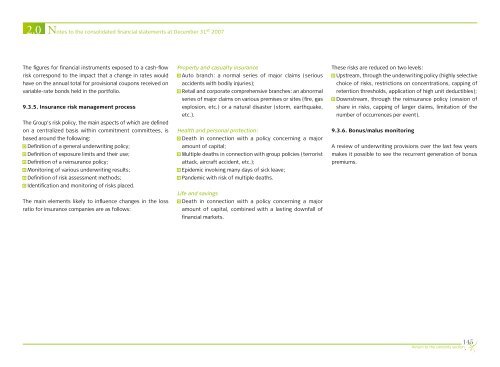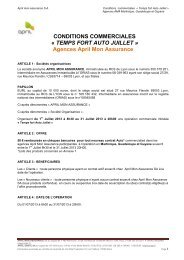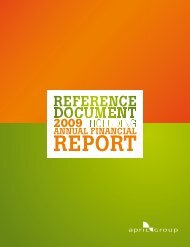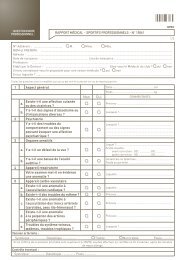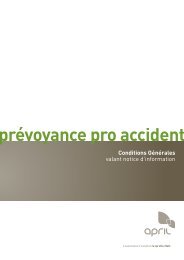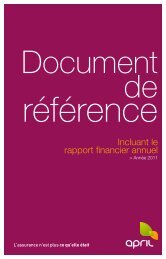2007 - April
2007 - April
2007 - April
You also want an ePaper? Increase the reach of your titles
YUMPU automatically turns print PDFs into web optimized ePapers that Google loves.
2.0<br />
Notes to the consolidated financial statements at December 31 st <strong>2007</strong><br />
The figures for financial instruments exposed to a cash-flow<br />
risk correspond to the impact that a change in rates would<br />
have on the annual total for provisional coupons received on<br />
variable-rate bonds held in the portfolio.<br />
9.3.5. Insurance risk management process<br />
The Group’s risk policy, the main aspects of which are defined<br />
on a centralized basis within commitment committees, is<br />
based around the following:<br />
Definition of a general underwriting policy;<br />
Definition of exposure limits and their use;<br />
Definition of a reinsurance policy;<br />
Monitoring of various underwriting results;<br />
Definition of risk assessment methods;<br />
Identification and monitoring of risks placed.<br />
The main elements likely to influence changes in the loss<br />
ratio for insurance companies are as follows:<br />
Property and casualty insurance<br />
Auto branch: a normal series of major claims (serious<br />
accidents with bodily injuries);<br />
Retail and corporate comprehensive branches: an abnormal<br />
series of major claims on various premises or sites (fire, gas<br />
explosion, etc.) or a natural disaster (storm, earthquake,<br />
etc.).<br />
Health and personal protection:<br />
Death in connection with a policy concerning a major<br />
amount of capital;<br />
Multiple deaths in connection with group policies (terrorist<br />
attack, aircraft accident, etc.);<br />
Epidemic involving many days of sick leave;<br />
Pandemic with risk of multiple deaths.<br />
Life and savings<br />
Death in connection with a policy concerning a major<br />
amount of capital, combined with a lasting downfall of<br />
financial markets.<br />
These risks are reduced on two levels:<br />
Upstream, through the underwriting policy (highly selective<br />
choice of risks, restrictions on concentrations, capping of<br />
retention thresholds, application of high unit deductibles);<br />
Downstream, through the reinsurance policy (cession of<br />
share in risks, capping of larger claims, limitation of the<br />
number of occurrences per event).<br />
9.3.6. Bonus/malus monitoring<br />
A review of underwriting provisions over the last few years<br />
makes it possible to see the recurrent generation of bonus<br />
premiums.<br />
145<br />
Return to the contents section


